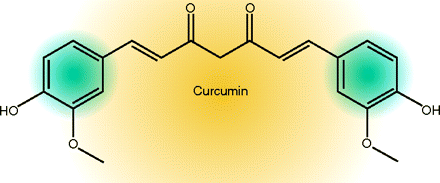Emerging concepts from the recent literature
Curcumin Sensitizes Cancer Cells for Radiotherapy Cells for Radiotherapy

Curry is the most popular spice admixture used in Indian food, and curcumin, one of the constituent compounds identified in curry, has garnered much attention as an anticancer identified in curry, has garnered much attention as an anticancer agent. In a Fast Forward publication in Mol. Pharmacol., Javvadi et al. demonstrate that curcumin increases the sensitivity of human cervical tumor cells to radiation and thus may be used in combination with radiotherapy for treating the disease. Radiation therapy combined with low doses of chemotherapeutic drugs is used widely for controlling advanced cervical cancer; however, combination therapy with chemotherapy drugs often leads to severe toxicity. In this report, the authors show that curcumin enhances the radiosensitivity of cancer cells without damaging normal human fibroblasts. Further, the authors suggested that increased production of reactive oxygen species and activation of the mitogen-activated protein kinases Erk1/2 are involved in curcumin-mediated radiosensitization. Although animal studies are needed to verify the curcumin-mediated effect in vivo, this study hints at strategies for topical application of curcumin to enhance the results of radiation therapy in the treatment of human cervical cancer. [Javvadi, P., Segan, A.T., Tuttle, S.W., and Koumenis, C. The chemopreventive agent curcumin is a potent radiosensitizer of human cervical tumor cells via increased ROS production and overactivation of the MAPK pathway. Mol. Pharmacol. Epub ahead of print; doi: 10.1124/mol.107.043554v1 (2008).]
—Z Dong, Hormel Institute, University of Minnesota
Hypomorphic RGS2 in Hypertension

Hypertension affects over 70 million people in the United States alone, yet the underlying etiology of the majority of cases remains unknown. Blood pressure phenotypes of RGS2- and RGS5-deficient mice have highlighted the importance of these Regulators of G-protein Signaling proteins in maintaining homeostatic control over vasoconstrictive and vasodilatory hormonal signaling. In a cohort of Japanese hypertensive patients, several mutations have been identified in the coding region of the human RGS2 gene. In a Fast Forward publication in Mol. Pharmacol., Gu et al. have found that one previously identified mutation in the N-terminal amphipathicα-helix of RGS2, R44H, results in subcellular mislocalization of a YFP-RGS2 fusion protein. Additionally, YFP-RGS2(R44H) was nearly 3-fold less effective than wild-type YFP-RGS2 in dampening carbachol-induced intracellular Ca2+ flux, establishing RGS2(R44H) as a bona fide hypomorphic allele. Elucidating the aberrant biochemical functions of mutant gene products in hypertension may lead to new targets for anti-hypertensive pharmacotherapy. [Gu, S., Tirgari, S., and Heximer, S.P. The RGS2 gene product from a candidate hypertension allele shows decreased plasma membrane association and inhibition of Gq. Mol. Pharmacol. Epub ahead of print; doi: 10.1124/mol.107.044214v1 (2008).]
—AJ Kimple and DP Siderovski, UNC-Chapel Hill
A New Molecular Target for Schizophrenia

Current therapeutics for schizophrenia require the physician and patient to strike a balance between limited therapeutic efficacy and a range of adverse effects which may interact with underlying genetic vulnerbilities. While the mainstay of almost all antipsychotic treatments has been blockade of dopamine D2 receptors, Schmidt et al. have suggested that selective inhibition of the cyclic nucleotide phosphodiesterase, PDE10A, may be a new pharmacological target. The authors have demonstrated that a selective PDE10A inhibitor, TP-10, is a highly potent, and selective tool which acts similarly to typical and atypical antipsychotic drugs on a battery of in vivo psychosis models ranging from suppression of stimulant (PCP and amphetamine)-induced hyperlocomotion, spontaneous locomotor activity, and conditioned avoidance responding. Currently, a phase 2 schizophrenia clinical trial for a PDE10A inhibitor is underway in the US Clinical validation of these preclinical data will be important not only in bringing forth a new treatment for schizophrenia, but should also inspire additional approaches to modulate the aberrant corticostriatothalamic circuits of schizophrenic patients. [Schmidt, C.J., Chapin, D.S., and Cianfrogna, J. Preclinical characterization of selective phosphodiesterase 10A inhibitors: A new therapeutic approach to the treatment of schizophrenia. J. Pharmacol. Exp.Ther.325 , 681–690 (2008). ]
—GJ Marek, Eli Lilly and Company
Making Light (and Dark) of Hepatic Gene Expression

That circadian rhythms affect observable behaviors is a long-appreciated concept. More subtle, but just as obvious, is the finding that circadian rhythms affect gene expression necessary to conduct quotidian physiological processes. Where does pharmacology fit in? With light cycle sensitive patterns of hepatic gene expression, of course. In a Fast Forward article published in J. Pharmacol. Exp. Therap., Almon et al. sought to discover which genes in rat liver are affected by light-dark cycles. Of 265 genes that appear to exhibit such periodicity, approximately 100 might be of potential value in the design of therapies. The largest group of transcripts (sixty-five) is associated with protein processing and translation, whereas the second largest group (thirty-five) has functions related to cell cycle and apoptosis. Overall, two-thirds of the circadian rhythm affected rat liver genes exhibit maximal expression during the active (or dark) period. The authors suggest that the data may be useful in cancer chemotherapy, whereby chemotoxicity might be reduced if “the circadian expression of drug targets in normal cells” can be elucidated. [Almon, R.R., Yang, E., Lai, W., Androulakis, I.P., DuBois, D.C., and Jusko, W.J. Circadian variations in liver gene expression: Relationships to drug actions. J. Pharmacol. Exp.Ther. Epub ahead of print; doi: 10.1124/jpet.108.140186 (2008).]
— JW Nelson, ASPET
- © American Society for Pharmacology and Experimental Theraputics 2008



